Wondering what all the fuss is about diminished chords?
We’ll show you everything you need to know about diminished chords in this comprehensive guide. You’ll learn how to use them in your music and discover their harmonic function.
Once you’ve mastered diminished chords, you’ll be able to add depth and sophistication to your music. Diminished chords can be used in various ways, so learning how to use them will open up new possibilities for your music.
Read the complete article below and get started on learning about diminished chords!
What Are Diminished Chords?
We briefly introduced you to the concept behind diminished chords in our article on “Triads Music.” As explained, the diminished triads have two minor thirds stacked over the root note, so they have the intervals R – m3 – m3, defining it. Hence, they are composed of the root note, minor 3rd, and a diminished fifth note, with the chord formula {1 – b3 – b5}.
A diminished triad is also known as a minor flat fifth triad. Instead of the perfect fifth in any major or minor chord, a diminished chord has a diminished fifth, six semitones above the root, hence its name.
Remember from the music theory that such an interval is also called a tritone, which is a very dissonant interval. Some even refer to it as a wild and unruly interval. In the middle ages, it even earned the name Diabolus in musica — the “devil in music.”
These chords are also known as dim chords and are denoted as Cdim or C°.
In addition to diminished triads, the diminished chords also come in other varieties, like the half-diminished chords and the full diminished 7th chords. We will apprise you of all of them in our subsequent sections.
How does the Diminished Triad Function in the Major Scale?
As you may be aware, a major scale in any key leads to 7 diatonic chords, each beginning at a different scale degree. This results in three major chords, three minor chords, and one diminished chord. The diminished triad occurs at the seventh scale degree.
In the C Major Scale, the triad built on the 7th scale degree is Bdim with the notes [B, D, F]. Any triad built on the seventh degree of a major key is also known as a leading tone triad since it is only one-half step away from the tonic in the next octave. Any leading tone has a tendency to resolve a half step higher or lower and is accordingly called a lower or upper leading tone. In the present case, a lower leading tone resolves to the tonic note.
The Diminished 7th chord
So far, you have seen the main aspects of a diminished triad having three notes. Let us now look at four-note chords or quadads. Generally, a quadad has an extra third stacked over a triad at the seventh interval. So you may consider it as an extended triad.
2 Types of Diminished Seventh Chords
As stated earlier, the diminished seventh chords can be classified into two types, as detailed below.
Diminished Chord with a Flat Seventh
These chords are also known as “minor seventh with flat fifth” or “Minor 7b5” in popular music styles. In classical music, they are called half-diminished chords. If you compare these chords with the Minor 7th chords [1 b3 5 b7], you will see that it is a minor 7th chord with a flat fifth [1 b3 b5 b7].
As you can see from the chord formula, it is composed of a root note, a minor third, a diminished fifth, and a minor seventh interval. This means we have two minor third intervals followed by a major third. These three intervals are in the reverse order of the corresponding dominant chords (Dominant 7).
Hence, the four notes for the half-diminished seventh chord are
C minor 7b5 or Cm7b5: {C Eb Gb Bb}.
The last three notes (3rd, 5th, and 7th) are (3, 3, 4) half steps away from their previous notes. These chords have a very unique sound that finds use in jazz music and sometimes in the blues. They are not frequently used in pop, rock, and other similar styles.
Diminished Chord with a Double Flat Seventh
This type of diminished seventh chord is also known as “Diminished 7,” or “Diminished Sevenths,” or “Full Diminished Chords.” These are represented by symbols C diminished 7 or Cdim7.
These chords go one step beyond the half-diminished chords and have three minor third intervals stacked over the root note. Hence they earn the designation of symmetrical chords. Other examples of symmetrical chords include the diminished and augmented triads.
This implies that the intervals always remain the same, whether you are ascending or descending the pitch. All the last 3 notes (3rd, 5th, and 7th) are three semitones away from the previous notes. Also, the 7th is three semitones or a minor third before the octave. Hence all the intervals from the root to the octave are minor thirds. You can start on any note and move up or down; you will get the same notes in a different order.
These chords are used in jazz to create a cool-sounding sequence. They sound dark, jarring, and unstable. Many experienced players find them interesting chords that can be used to create a dramatic effect.
The chord formula is [1 b3 b5 bb7], where bb7 is a double-flatted 7th, the same as the sixth scale degree.
Cdim7: {C Eb Gb Bbb} or {C Eb Gb A}
How to use Diminished Chords
The diminished chords serve several functions in all styles of music, as you will learn in this section. They have been used to provide moments of extreme tension to the audience.
A piece of consonant music tends to reduce the tension known as the resolution and may sound nice, easy to listen to, and pleasing. On the other end of the spectrum, real movement in music requires dissonant sounds that lead to tension, appear surprising, or outright harsh.
The diminished fifth is an interval with dissonant sound against the major and minor triads made up of only consonant intervals and used in most melodies in popular music. It is important that you understand the behavior of diminished chords and use them to your advantage.
The diminished chords have a jazzy flavor and are suited for the style that emphasizes the dominant function or voice leading. Any chord is said to have a dominant function if it creates an instability that can be resolved by tonic only.
Dominant triads, leading tone triads, leading tone sevenths, seventh, and ninth chords usually have dominant functions.
A Diminished Triad
To begin with, let us introduce you to the applications of a diminished triad before moving on to the diminished 7ths.
Use as a Passing Chord in the Chord Progressions
You can think of passing chords in chord progressions as a bridge between the tonic (I) and the minor chord (ii) a whole step above. This is often known as the I – ii bridge. You can see the details in the next section.
Similarly, you can move from chord I to vi with a flat vi diminished chord in between. In this application, the diminished chords allow a smooth resolution by reducing the friction between two chords instead of adding tension or appearing jarring if you play them alone.
There are other possibilities and situations where you can use the diminished triad as a passing chord. However, let us elaborate on the concept behind the application for your easy understanding.
The I-ii bridge
You already know that chord (I) is a major and ii a minor. Consider the C major chord (I) with notes [C E G] and D minor as the chord (ii) with notes [D F A]. If we introduce C#dim chord with notes [C# E G] between C major and D minor in the chord progression, the bass note moves from C to C# and then to D providing a smoother transition.
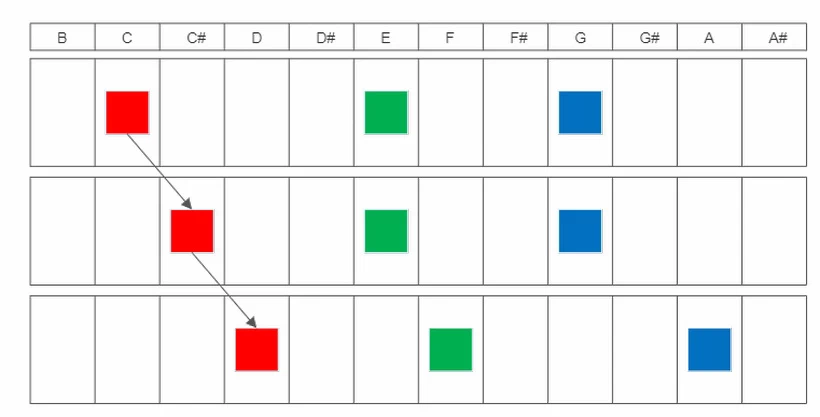
Leading to a vi Chord
Similarly, you can transition between chords (I) and (vi) by introducing a flat vi chord in between. So the progressions are
- The second inversion of the chord (I) is followed by flat vi and the vi chord. For example, the second inversion of G major [D G B], followed by Ebdim [D# F# A], followed by Em [E G B]. This leads to a stepwise ascendancy in the bass notes D to D# to E.
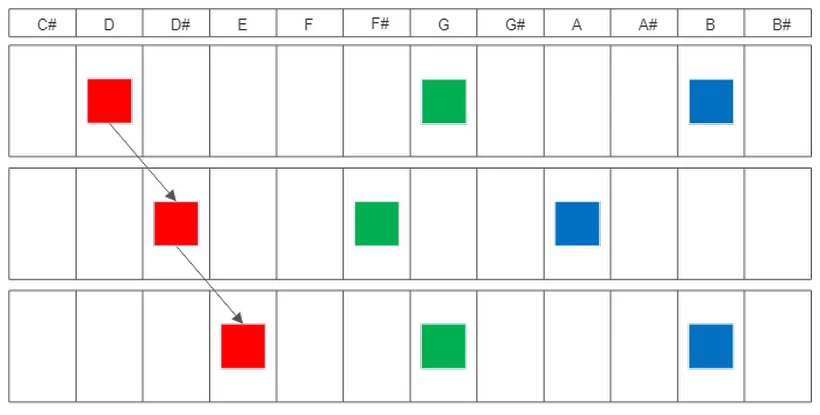
- Chord (I) is followed by the first inversion of the flat vi chord and the first inversion of the vi chord. Considering the same example, G major [G B D] is followed by the first inversion of Eb [F# A D#] and the first inversion of Em chord [G B E]. This leads to a stepwise ascendancy in the lead notes from D to D# to E.
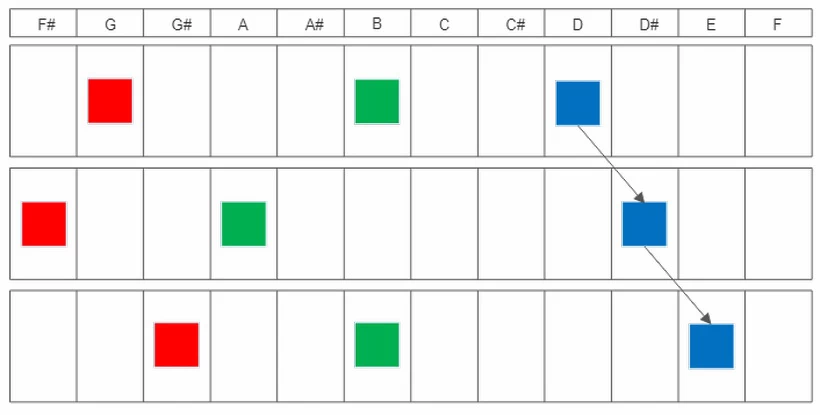
Use of Resolution of a Diminished Triad.
We had stated earlier that any leading tone triad has a tendency to resolve to the tonic. The leading tone triad consists of the seventh, second, and fourth tones of a major scale. It resolves to the first, third, and fifth tones of a major scale: half step, whole step, and a whole step above the leading triad tones. In the key of C, Bdim [B, D, F] resolves to C Major [C, E, G].
You can use the above property and create a leading note to any scale degree of a major scale and then form a leading move triad that will resolve to that particular scale degree.
A Diminished Seventh Chords
Let us apprise you of how the resolution of diminished seventh chords works in the sections below.
Resolution of A Fully Diminished Chord
As stated earlier, the fully diminished chords have overlapping diminished fifths, and the fourth note is nine semitones above the root. Consider an E-diminished 7 chord with the notes: [E, G, Bb, Db].
The overlapping diminished fifths in [G, Bb, Db] can resolve as:
- Db resolves to C, G and Bb resolves to Ab. In addition, the root E resolves to F, forming a minor triad [F, Ab, C].
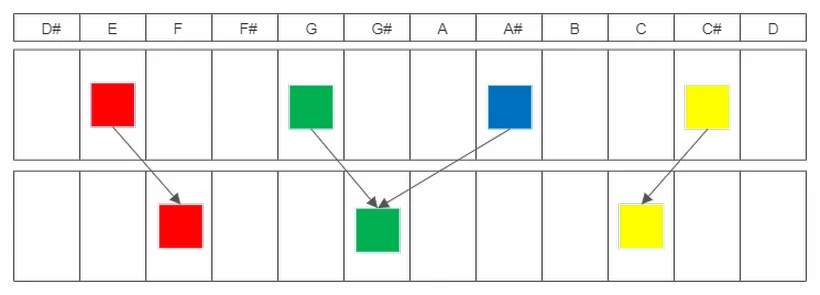
- Db resolves to C, G and Bb resolves to A. In addition, the root E resolves to F, forming a major triad [F, A, C].
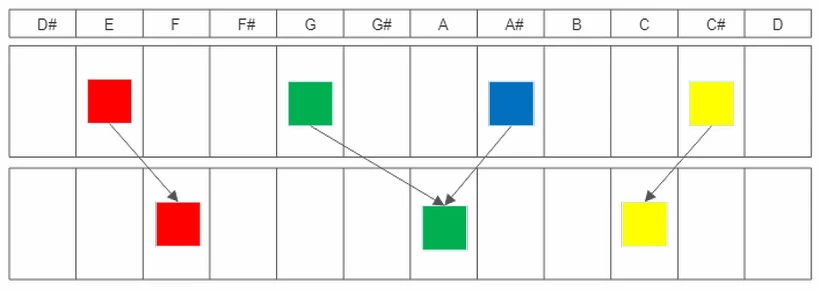
Resolution of Half a Diminished Chord
The half-diminished chords have intervals of a minor third, a minor third, and a major third stacked over the root. Let us again consider the example of an E half diminished chord denoted by E minor 7b5 having the notes [E, G, Bb, D]. In this case, instead of the last three notes, we will consider the first three notes [E, G, Bb] forming the diminished triad and resolve them like below:
- Bb resolves to A, E resolves to Gb. In addition, the note D remains as it is, forming a first inversion of the major triad [Gb, A, D].
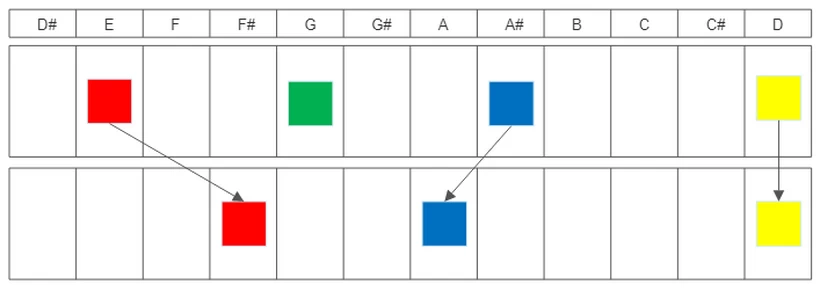
- E resolves to F, G and Bb resolves to A. In addition, note D resolves to C, forming a major triad [F, A, C].
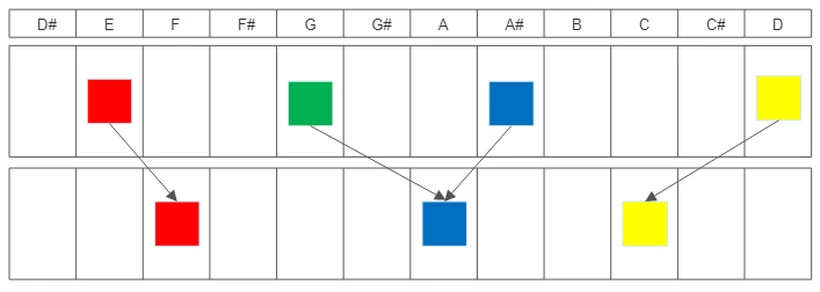
- E resolves to F, G and Bb resolves to Ab. In addition, note D resolves to C, forming a minor triad [F, Ab, C].
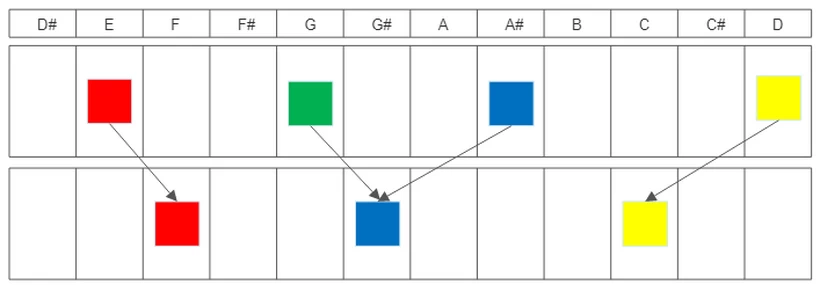
- E resolves to Gb, G and Bb resolve to A. In addition, note D resolves to Db, forming a minor triad [Gb, A, Db].
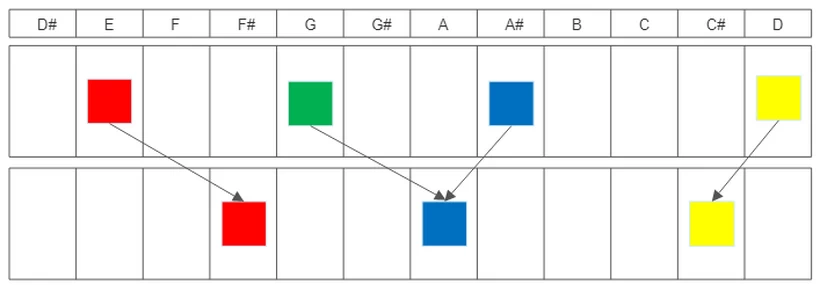
Use them in place of Dominant chords.
The V chord is the dominant chord in both minor and major keys. You can substitute the V chord by a diminished chord by making use of the dominant function. In the key of C major, the V chord is G7 with the notes: [G, B, D, F]. The last three notes [B, D, F] form the B diminished triad. You can use the Bdim or Bdim7 chord instead of the G7 chord.
Conclusion
Diminished chords are an important part of the music. They are used to create a feeling or color in a chord progression. This article looked at diminished chords and how they can be used in your music compositions. I hope you found this information helpful! Let me know in the comments section if you have any questions.
